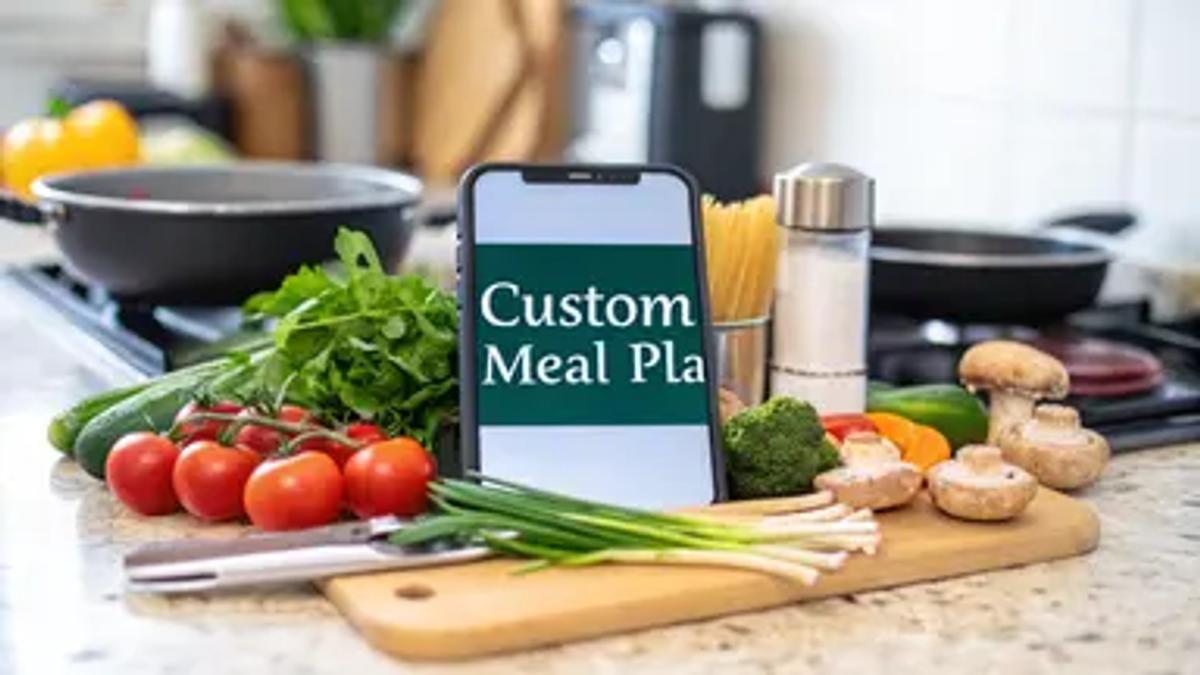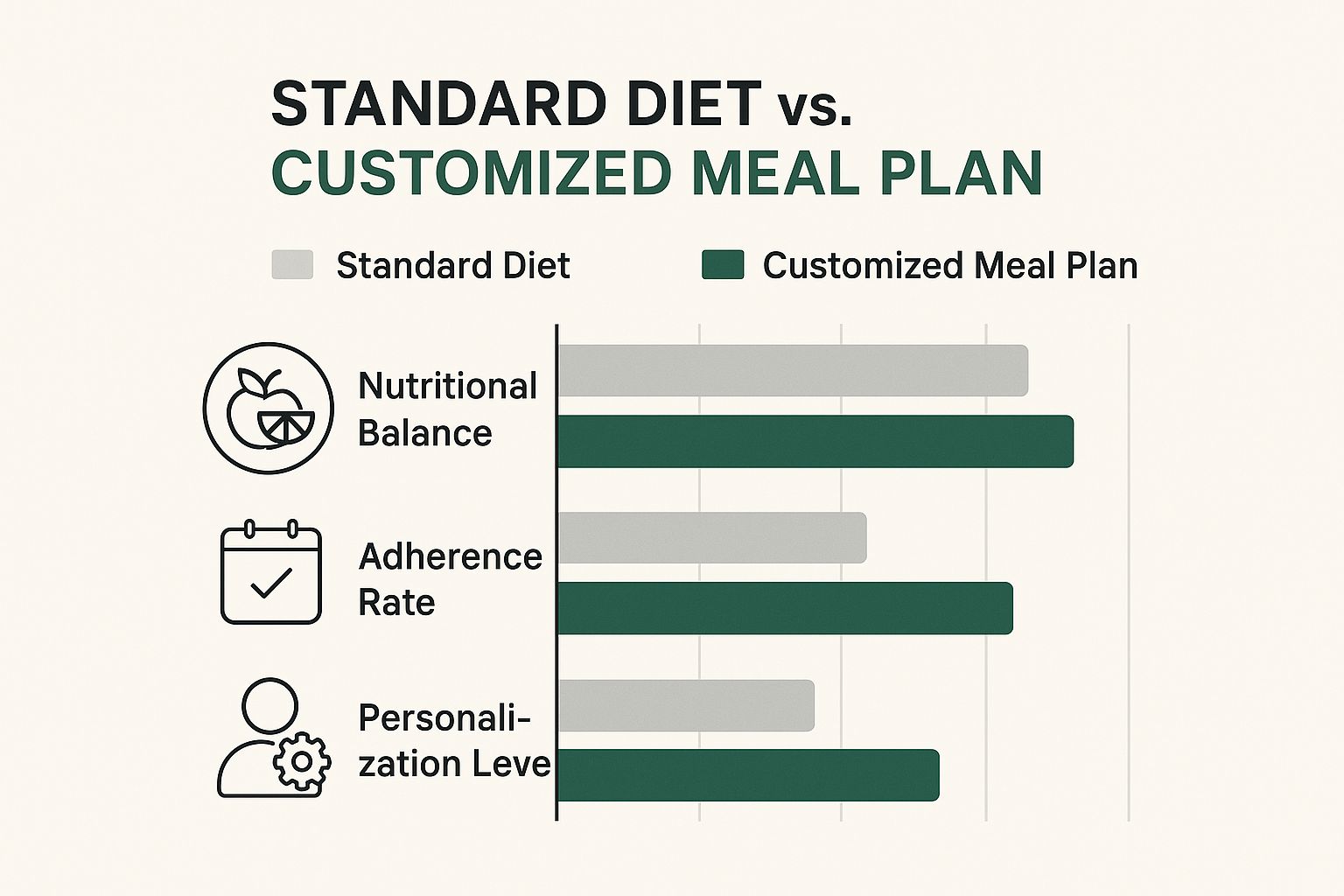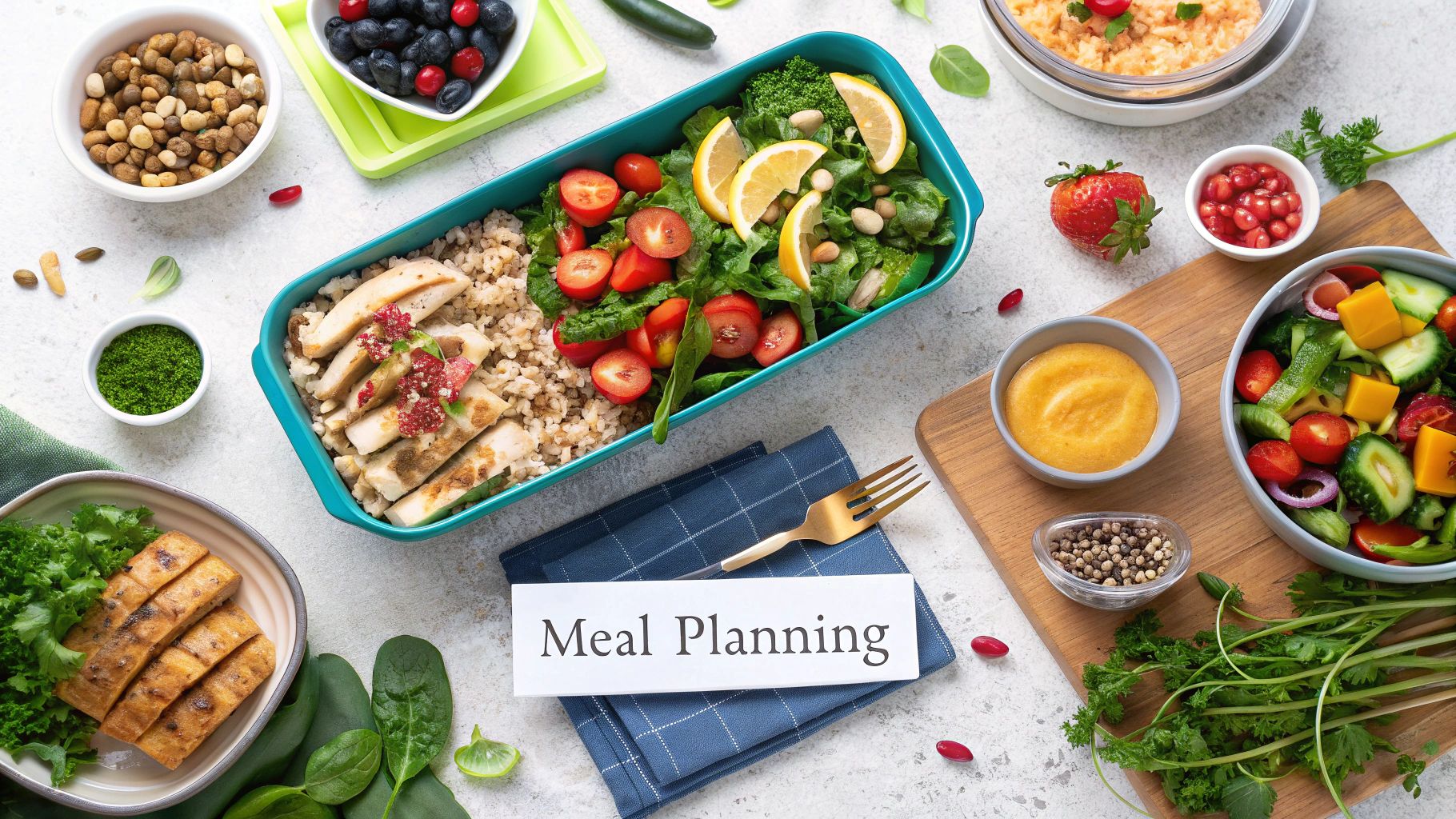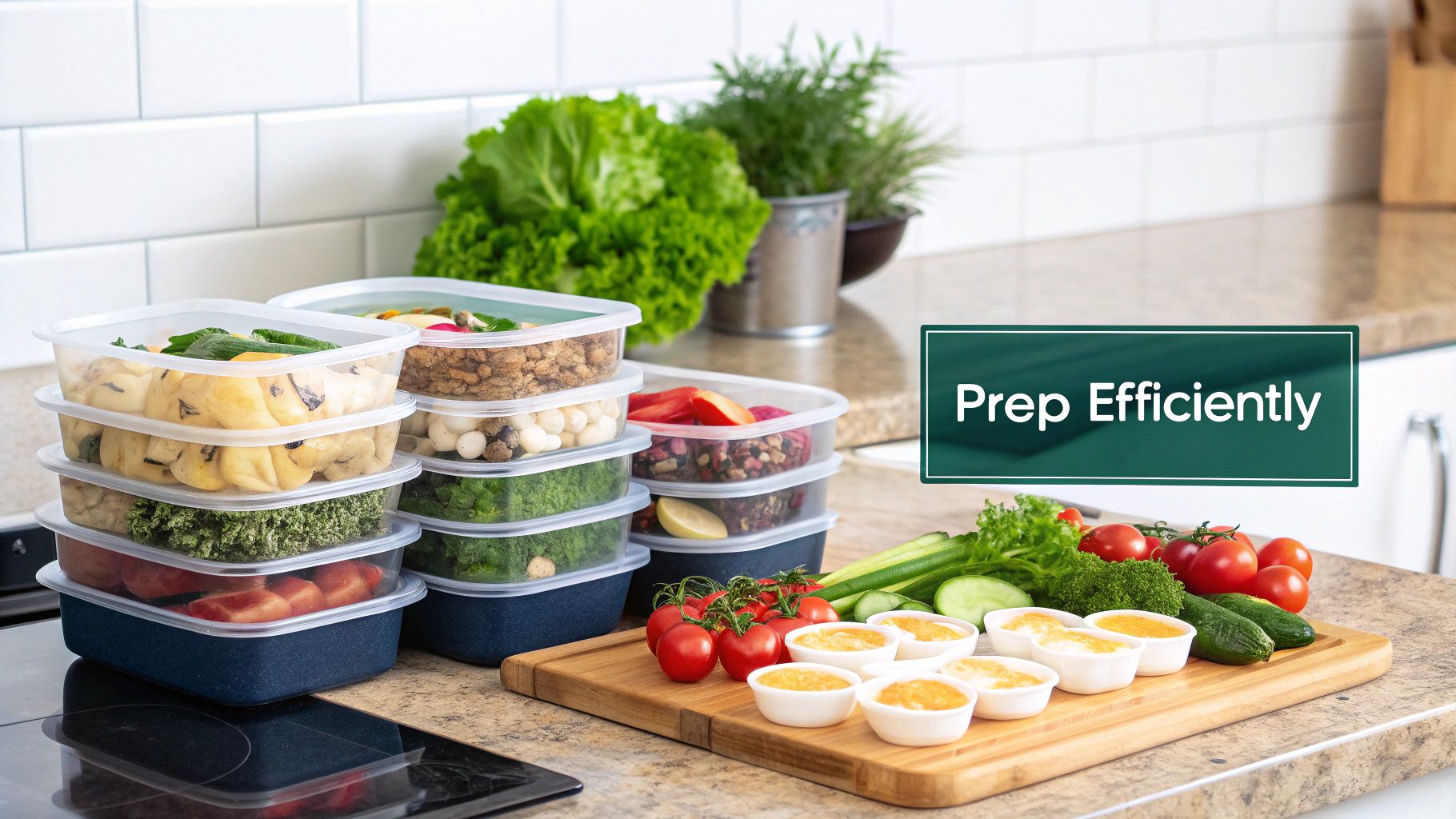Your Guide to a Customized Meal Plan
Ditch dinner stress with a customized meal plan. This guide for busy parents shows you how to use AI to save time, money, and your sanity. Start today!
Ready to Simplify Your Meal Planning?
Get personalized meal plans and grocery lists automatically matched to your macro targets.

Your Guide to a Customized Meal Plan
Does the daily "what's for dinner?" question fill you with a special kind of dread? If so, you're in good company. A customized meal plan is the ultimate secret weapon for any parent, built specifically around your family's one-of-a-kind tastes, dietary quirks, and, of course, your budget. It's the simple trick that turns chaotic evenings into calm, delicious dinners.
Escape the 5 PM Scramble for Good
As a parent, you’re already a master juggler. But add picky eaters, food allergies, and a grocery budget that feels tighter every week, and mealtime can feel like a high-stakes circus act. You've probably tried to plan before, downloading generic templates that don't know your son gags at the sight of broccoli or that Tuesdays are a 20-minute-meal-or-bust kind of day.
This is where a truly personal approach completely changes the game.
We're not just talking about jotting down a few meal ideas on a sticky note. Think of it as creating a smart system that actually learns what your family loves and adapts to your ever-changing schedule. Imagine a plan that suggests dinners you're excited to cook and helps you stick to your grocery budget like a pro.
The Old Way vs. The Smart Way
Let’s be honest, traditional meal planning is a bit of a nightmare. It often involves digging through dusty cookbooks, scrolling through endless Pinterest boards, and making those frantic, last-minute trips to the store for that one forgotten ingredient. It’s a ton of work for a static piece of paper. An intelligent system, on the other hand, does all that heavy lifting for you.
- Picky Eaters? No Problem: Instead of working around your kid's "no-go" list, you can just tell the system which ingredients are banned from the kingdom.
- Budgeting Bliss: It helps you nail your spending goals by creating shopping lists with military precision, slashing food waste and those sneaky impulse buys.
- More Time for You: It automates the most boring parts of the process, from finding new recipes to writing out your grocery list.
The difference is night and day. Let's break it down.
Meal Planning Old School vs New School
Here's a quick look at how a modern, AI-powered approach stacks up against the old-fashioned way of doing things.
| Feature | Traditional Meal Planning | AI-Powered Meal Planning |
| Customization | Manual and limited. You have to remember everyone's preferences. | Highly personalized. Learns and adapts to tastes, allergies, and diets. |
| Time Investment | High. Requires hours of searching, planning, and list-making each week. | Minimal. Generates a week's worth of meals in a few clicks. |
| Grocery Lists | A manual, often forgotten, task. Easy to miss ingredients. | Automatic and accurate. Creates a perfect list based on your chosen meals. |
| Recipe Variety | Stagnant. You tend to fall back on the same 5-10 meals. | Endless. Discovers new recipes based on ingredients you actually like. |
| Flexibility | Rigid. A change in plans can throw the whole week off. | Super flexible. Easily swap meals, adjust servings, or add last-minute dinners. |
| Waste Reduction | Difficult. Often leads to overbuying and spoiled food. | Optimized to reduce waste by planning for leftovers and using ingredients efficiently. |
As you can see, it’s not even a fair fight. One method adds to your mental load, while the other lightens it significantly.
This chart really drives the point home, showing just how much better a plan built for your life works.

When a plan is designed around your reality, you're far more likely to stick with it and get the results you want.
Why Everyone Is Jumping on This Bandwagon
This move toward personalized planning isn't just some passing fad. It’s part of a huge shift as we all look for smarter, easier ways to manage our health and our homes. In fact, the global market for custom meal planning services was valued at roughly USD 4.5 billion in 2024. This boom is all about two things: a bigger focus on personal health and a desperate need for convenience in our busy lives. If you're curious, you can explore more data about this growing market and see how people's habits are changing.
The biggest flaw with most meal plans is that they were never really your meal plans to begin with. A customized plan actually works because it starts with your family's reality—your schedule, your budget, and yes, your kids' constantly changing opinions on food.
At the end of the day, using a smarter planning method is about buying back your time and dialing down the stress. It transforms a dreaded daily chore into a simple, manageable part of your routine, giving you more energy to spend on the people and things that really matter.
Alright, let's ditch the robot-speak and talk about training your new AI meal planning sidekick.
Schooling Your AI: How to Lay Down the Law on Food
Imagine you just hired a personal chef. You wouldn't just hand them a credit card and say, "Make us some healthy food." You'd sit them down for a serious heart-to-heart, right? You’d talk about your son's violent opposition to mushrooms, your daughter’s sudden obsession with tacos, and that weird no-peanut rule for playdates.
Treating your AI meal planner exactly like that is the secret sauce. This initial brain-dump is where a generic app becomes your family's personal meal guru. You’re not just filling out a form; you’re painting a detailed, sometimes brutally honest, picture of your family’s entire food universe.
Don't just say "we have allergies." Get specific. "Sam has a life-threatening peanut allergy, so our house is a 100% peanut-free zone." The more dirt you give the AI, the better it gets at dodging those meal plan landmines. No more staring at a recipe suggestion that would send someone to the ER or cause a dinner-table meltdown.
Setting Your "No-Go" Zones
Let's get down to business and draw some hard lines in the sand. This is where you establish the absolute, non-negotiable rules of your kitchen. Your goal is to feed the AI every single deal-breaker so it doesn’t even think about suggesting something that’s off-limits.
First, tackle the big, important stuff—health and safety. These are the foundations of your customized meal plan.
- Allergies & Intolerances: Be crystal clear. Think "Mom has Celiac disease, so all meals must be strictly gluten-free," not just "gluten-free." Or, "No peanuts or tree nuts in the house for Sam's allergy."
- Dietary Goals: Are you trying to cut carbs? Need to watch your blood pressure? Spell it out. For example, "We need a heart-healthy, low-sodium diet."
- Medical & Health Needs: A dietitian might design a plan for PCOS or diabetes, and you can teach your AI to do the same. Input rules like "PCOS-friendly meals focusing on complex carbs and lean protein" or "Find low FODMAP recipes for IBS."
Here's a little secret from the trenches: The plans you actually stick with are the ones that fit your real, messy life. Being totally upfront with your AI—about the picky eating, the weird food rules, all of it—is the shortcut to a plan that finally works.
With the serious rules in place, it’s time for the fun part: making sure the food is something people actually want to eat.
Cracking the Picky Eater Code
Ah, the final boss of family meals: the picky eater. A standard meal plan has no idea that your 6-year-old, Leo, views all green vegetables as a personal affront. But your AI? It can learn. You just have to give it hilariously specific instructions.
Let's build a profile for our little friend Leo:
Picky Eater Profile: Leo, Age 6
- Hates: Cooked mushrooms (slimy!), onions in any form (yuck!), and anything remotely "spicy."
- Loves: Pasta (Tuesdays are sacred), chicken nuggets, and plain cheese pizza. No toppings. Ever.
- Will Eat Under Duress: Broccoli if smothered in cheese sauce, raw carrot sticks (but not cooked ones).
See? Now the AI knows not to bother with that delicious-looking mushroom stroganoff on a Tuesday.
Finally, tell it about your life. Are you a "30-minutes or it's takeout" kind of parent on weeknights? Do you secretly love a lazy Sunday afternoon cooking project? Let the AI know! Tell it things like, "Weeknight dinners must have under 30 minutes of active prep time," and "Only show me recipes that take over 45 minutes on Saturdays or Sundays." This way, your customized meal plan serves you, not the other way around.
Let's Cook Up Your First Perfect Week of Meals

Alright, this is where the real fun begins. You’ve just poured your heart out to the AI, detailing every picky preference, every allergy, and every "absolutely-not-broccoli" rule your family lives by. Now it's time to hit the big shiny button and let your new kitchen sidekick work its magic.
But remember, the first plan it spits out is a first draft, not a final command. Think of it as a creative brainstorming session. Your job is to poke, prod, and tweak it until that schedule fits your family’s life like your favorite comfy sweater. This little dance between you and the AI is what makes it a truly customized meal plan.
Putting Your First Plan to the Test
Let’s get real for a second. Your week is a beautiful mess of different needs, right? Maybe you need a dinner that's faster than a speeding toddler on Tuesday, a healthy-ish lunch just for you on Thursday, and a "let's-get-this-weekend-started" pizza night on Friday.
You plug this into Meal Flow AI and get your first draft. Here’s how you might whip it into shape:
- Tuesday's Dinner Drama: The AI suggests a 25-minute "One-Pan Lemon Herb Chicken and Veggies." It's fast, it's simple, it's a keeper. Keep.
- Thursday's Solo Lunch: It offers up a quinoa salad. Healthy, yes, but you’d rather eat the box it came in. A quick click on the "swap recipe" button reveals a "Greek Yogurt Chicken Salad Wrap." Now that's more like it. Swap.
- Friday Pizza Party: The AI gives you a standard pepperoni pizza recipe. Cute, but you can do better. You’ll just edit the title to "Build-Your-Own Pizza Night!" and add a bunch of fun toppings like olives, peppers, and mushrooms to the grocery list. Edit.
See? The AI does the heavy lifting, but you're the one with the director's chair, making the final calls.
Become a Leftover Genius
One of my favorite things to do is to get clever with leftovers, and the AI is a fantastic partner in crime. This isn't just about pinching pennies; it’s about cooking smarter, not harder, and kicking food waste to the curb.
For instance, if you're having a big roast chicken on Sunday, tell the AI to factor in the leftovers. It might brilliantly suggest shredding the extra chicken for those chicken salad wraps you just scheduled for Thursday. Boom—one less thing on your shopping list and zero wasted chicken.
The AI isn’t a rigid boss; it’s a creative assistant. The real power comes from making those small, manual tweaks that reflect your family's rhythm. A great customized meal plan feels less like a set of instructions and more like a helpful guide built just for you.
And you're not alone in wanting this. The market for these kinds of meal solutions hit a staggering USD 485.52 million in 2024 and is only getting bigger. Families everywhere are looking for smarter, healthier ways to handle the daily "what's for dinner?" grind. If you're a data nerd like me, you can explore the full meal planning market forecast and see just how massive this trend is.
The takeaway? You’re not just saving time—you’re joining a movement toward a simpler, smarter way of life.
Put Your Grocery List on Autopilot

So you've done it. You’ve crafted a week of meals so perfect, so delicious, that even your pickiest eater has gone quiet. That’s a major win! But let's be real, now comes the part we all secretly hate: turning that beautiful plan into a grocery list that actually makes sense.
It’s the last tedious hurdle, right? You're squinting at recipes, trying to add up "a pinch of this" and "a handful of that," all while praying you don’t forget the one critical ingredient for Thursday's tacos. This is usually where the best-laid plans go to die, lost in a flurry of sticky notes and "oops, I forgot the cheese!" moments.
But what if you could just... skip that whole part? With a tool like Meal Flow AI, that chore basically vanishes. The second your customized meal plan is locked in, the system instantly crunches all the numbers and spits out one smart, organized shopping list. No more manual counting, no more headaches.
Master Your List Like a Pro
An automated list is fantastic, but a managed automated list? That's where you start saving serious cash and reclaiming your sanity. This isn't just about having a list; it's about making that list work for you. Before you even dream of grabbing a shopping cart, a couple of quick checks can make all the difference.
First thing's first: shop your own kitchen. The AI gives you the "perfect world" list, but you live in the real world.
- Pantry Raid: Run a quick scan of your pantry. Does the list say you need paprika? Is there already a jar hiding behind the Cheerios? Uncheck it.
- Fridge & Freezer Recon: Do the same for the cold stuff. You might find half a carton of chicken broth or a bag of frozen peas just waiting for their moment to shine.
This super-simple step stops you from buying what you already own—a sneaky little habit that drains the grocery budget over time. It’s the golden rule of frugal food shopping: use what you've got!
The whole point is to take a chaotic, budget-busting chore and turn it into an automated, money-saving win. A smart grocery list doesn't just tell you what to buy; it helps you buy smarter by connecting your meal plan to the food you actually have in your house.
From Aisle Surfing to a Lightning-Fast Checkout
Okay, you’ve trimmed the fat from your list. Now for the fun part. Instead of a random jumble of ingredients, the AI-generated list is smartly organized by grocery store category—produce, dairy, meats, pantry goods. This changes your shopping trip from a frantic zig-zag across the store into a streamlined, efficient mission.
Picture this: you walk into the store and know exactly where you're going. You can blitz through the produce section, swing by dairy, hit the meat counter, and be on your way. No more aimless wandering, which, let's be honest, is where all the impulse buys happen. Suddenly, that "buy one, get one" deal on a family-sized bag of gummy sharks doesn't seem so tempting when you're on a mission.
And for the ultimate "I've got this" moment? You can connect your list directly to grocery delivery services like Instacart. With just a few clicks, your entire week's shopping is headed straight for your front door. It’s the final piece of the puzzle, putting your grocery shopping on complete autopilot and giving you back hours of your precious time.
Become a Meal Planning Power User

Alright, you've nailed the basics. Your weekly plan is probably already saving you from that dreaded 5 PM "what's for dinner?" panic. Now, let’s kick things up a notch and turn you into a true meal-planning wizard.
This is where you go from just using a meal planner to making it an indispensable part of your family's rhythm. We're talking about a system so in sync with your life, it practically reads your mind.
Make Your Meal Plan Fun (Yes, Really!)
The secret to sticking with any system is making it something your family actually enjoys. Think about your weekly traditions—the little food rituals that everyone looks forward to. If your house runs on Taco Tuesdays or Pizza Fridays, you can actually teach the AI to build your week around them.
Here’s how to make it happen:
- Taco Tuesdays: Just tell the AI, "Always schedule a taco-related meal for Tuesday dinner." It's smart enough to mix it up, suggesting fish tacos one week and a taco-inspired casserole the next. No more boredom!
- Meatless Mondays: Set a simple rule to "only suggest vegetarian or vegan meals for Mondays." It’s a brilliant, zero-effort way to explore new plant-based dishes.
- Pizza Fridays: Lock in a "pizza night" for every Friday. Boom. The end of the week is officially stress-free and fun.
These little automations make your plan feel wonderfully predictable, giving your family something tasty and familiar to count on.
Teach the AI Grandma's Secret Recipes
But what about those irreplaceable family recipes? You know, the ones written on a stained index card that have been passed down for generations. Good news: you can add them right into your plan.
Take a few minutes to type in the ingredients and instructions for Grandma’s legendary lasagna or your uncle’s famous chili. Once they're in the system, the AI can slot them into your schedule and—this is the best part—automatically add every single ingredient to your shopping list.
The real magic happens when your meal plan reflects not just what you eat, but how you live. Weaving in your family’s traditions and favorite recipes transforms a functional tool into a part of your home.
This kind of deep personalization is more than just a cool feature; it's what people are looking for. The demand for a customized meal plan is surging, partly for public health reasons. With nearly 70% of U.S. adults classified as overweight or obese by the CDC, families are actively seeking personalized tools to manage their health. You can see the data on these health-driven market trends to get the full picture.
Adjust and Analyze on the Fly
Let's be real—life is unpredictable. The in-laws announce a surprise weekend visit, or your kid invites the entire soccer team over after a game. A power user doesn't panic. You can instantly adjust portion sizes for any meal.
Just tell the AI you need to feed eight people instead of four for Saturday dinner. It will recalculate the recipe and update your grocery list in a flash.
Over time, you can also glance back at your past plans. Maybe you'll notice a heavy reliance on pasta, or discover that your family absolutely devours one-pan dinners. This insight is gold. It helps you fine-tune your approach, making your customized meal plan healthier and more effective with each passing week.
Let's Tackle Those Lingering Meal Plan Questions
Alright, let's be real. Diving into a new app, especially one that promises to solve the eternal "what's for dinner?" nightmare, can bring up a few questions. It’s totally normal to feel a little skeptical. You’re probably thinking, "Yeah, right. Can it really handle my family's beautiful chaos?"
We've heard all the big questions from parents who were standing right where you are now. So, let's just get them out in the open and put your mind at ease.
"Can It Really Handle My Kid's Super-Specific Diet?"
This is the big one, isn't it? The question we get more than any other. And my answer is always a huge, confident YES. This isn't about picking from a generic "gluten-free" or "dairy-free" list and hoping for the best. Think of a smart AI planner as your own personal (and very affordable) dietitian.
You can throw a whole mess of overlapping needs at it. Seriously. Let's say you need a customized meal plan that's:
- PCOS-friendly for you, keeping blood sugar stable.
- Nut-free because of a child's serious allergy.
- High-protein for your teenage son who eats like he’s training for the Olympics.
The system is built to juggle all those rules at once. It digs through thousands of options to find recipes that check every single box, not just some of them. It’s not about finding a bland compromise; it’s about finding delicious meals that genuinely work for everyone at the table.
"Will It Just Give Me Weird, Complicated Recipes?"
Nobody—and I mean nobody—has the energy for a recipe with 27 steps on a Tuesday night. I get it. The good news is, you've already told the AI you're not a Michelin-star chef with a fully staffed kitchen.
It knows you need quick and easy. If you said you have 30 minutes on weeknights, it won't be suggesting a beef wellington. It's programmed to respect your reality.
And remember, you are always the boss. If a recipe looks too fussy or calls for an ingredient you know you'll never find, just smash that "swap" button. A new, better-fitting idea will pop up instantly.
Your customized meal plan should make your life easier, not give you more homework. The AI's whole job is to cut through the clutter and hand you awesome, doable ideas you'll actually cook.
"How Is This Different from a Regular Meal Planning App?"
Ah, a fantastic question. Most of those other apps are basically just digital recipe binders. You can save stuff, maybe make a list, but the "thinking" part is still all on you. The magic of an AI-powered system is right there in the name: intelligence.
A platform like Meal Flow AI doesn't just hold onto your preferences; it actually learns from them. It starts to notice that your family goes wild for anything with chicken and rice but collectively groans at the sight of fish. It picks up on the fact that you always swap out recipes that require a food processor.
This means your plans get smarter and more personalized week after week. It’s the difference between a static, printed-out list and a living, breathing assistant that truly gets your family. Your customized meal plan evolves as your tastes do, so it always feels like it was made just for you.
---
Ready to stop wondering and start planning? Let Meal Flow AI take the guesswork out of dinnertime. Create your first perfectly personalized meal plan and automated grocery list in minutes. Get started with Meal Flow AI today!